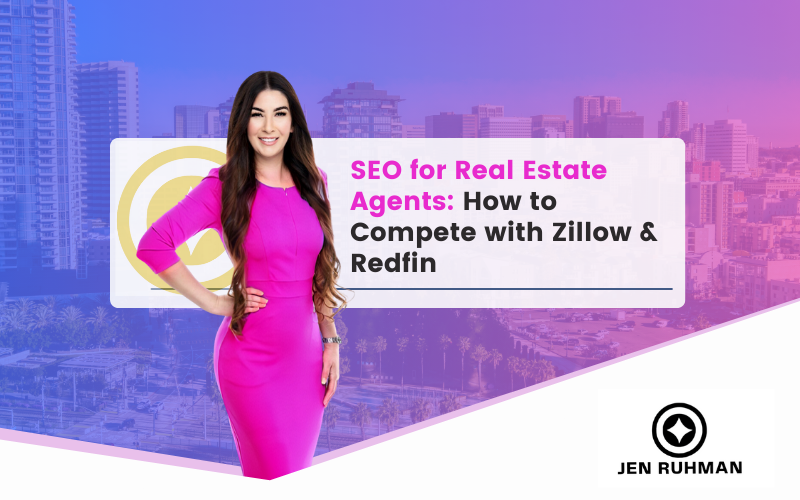SEO for Real Estate Agents: How I Compete with Zillow & Redfin (From a San Diego SEO’s Playbook)
Quick Answers (Fact-Based)
- Can a solo agent outrank Zillow/Redfin? Yes—especially on hyper-local, intent-driven searches (neighborhood + property type + situation), and for brand and “near me” queries with strong E-E-A-T and Local SEO.
- What moves the needle fastest? Optimized Google Business Profile, unique neighborhood pages, internal linking, FAQs with clear answers, strong CTAs, and consistent reviews.
- Does AI search/SGE change the plan? A bit. Include short, direct answers at the top of key pages, add structured data (FAQ/LocalBusiness), and keep content people-first with real examples.
- Timeline to see results? Many agents see early wins in 30–60 days for local queries; competitive neighborhoods often take 3–6 months with consistent publishing and links.
- Need help now? Call/text me: (619) 719-1315.
Who I Am & Why Listen to Me
I’m Jen Ruhman, owner of a San Diego-based SEO practice at JenRuhman.com. I’ve helped agents and boutique brokerages compete against the big portals by focusing on local entity building, helpful content, and technical clarity.
When I first started working with a solo agent in North Park, she told me, “Jen, Zillow owns everything.” Three months later, her “North Park Craftsman homes guide” beat portals for several long-tail queries and pulled in seller leads who found her market explainer, walkability notes, and renovation tips more trustworthy than generic pages.
My approach is simple: own your neighborhood, show real experience, and make it easy for Google—and buyers/sellers—to understand who you are and why you’re the best local guide.
Why Zillow & Redfin Win—and Where They Don’t
Portals dominate broad keywords (e.g., “San Diego homes for sale”). But they’re weaker on:
- Hyper-local intent (e.g., “Bay Park townhomes near Clairemont Drive Station,” “best condos for VA loans in Point Loma”)
- Experience-rich guides (before/after case studies, permit quirks, school nuances)
- Local authority signals (consistent NAP, Google Business Profile activity, local press, neighborhood photos you actually shot)
Your goal: Out-niche and out-help.
The 5-Part Strategy I Use to Compete
- Local Entity Mastery (Google Business Profile + citations)
- Hyper-Local Pages that answer real questions with real examples
- AI/SGE Optimization with direct answers and schema
- Technical SEO that keeps crawl paths clean
- Authority & Links earned from useful, community-first content
1) Own Your Local Entity (Google Business Profile Done Right)
Core Setup
- Primary category: Real Estate Agent (or Real Estate Consultant if applicable).
- Add services/products (Buyer Representation, Listing Agent, Probate Sales, VA Buyers, Relocation, etc.).
- Service areas: list specific neighborhoods (La Jolla, Pacific Beach, North Park, Point Loma, Del Mar, Chula Vista).
- Hours, phone (trackable if needed), UTM-tagged website URL.
GBP Content System
- Weekly Posts: “3 things I’m seeing in Bay Park this week,” “Open house notes from Ocean Beach,” quick 100–200-word insights.
- Q&A: Seed with your own FAQs in plain language (e.g., “Are Mello-Roos common in Eastlake?”).
- Photos: Original, geotag not necessary, but keep them authentic: streetscapes, parks, transit, school drop-offs, condo amenities.
- Reviews: Ask for specifics (“Jen helped us win a VA offer near Liberty Station”). Specifics = keywords you don’t have to stuff.
Citations & Consistency
- Keep your NAP consistent on SDAR profile, Yelp, Nextdoor, Apple Maps, Bing Places, Realtor.com profile, and your brokerage bio.
- If you also serve North County (Carlsbad, Encinitas, Del Mar), make sure that’s visible across profiles.
2) Build Neighborhood Pages That Actually Win
The Blueprint for Each Page
- Direct Answer Box (3–5 bullets): “What buyers ask about [Neighborhood].”
- Map + Boundaries (embed if possible), commute notes (e.g., I-5 vs SR-163), parking rules.
- Home Types & Price Ranges (evergreen ranges, not MLS feeds).
- School & Lifestyle Notes: real, parent-level practical tips—drop-off lanes, after-school programs, dog-friendly parks.
- Micro-areas: sections for “South Park vs North Park,” “Bird Rock vs Village (La Jolla).”
- Buyer/Seller Situations: VA buyers, condo litigation issues, ADU potential, historic (Mills Act).
- My Take (Experience): a short anecdote—“Last spring I helped a young family win in Bay Ho by…”
- CTAs: calendar link, “text me,” and a low-friction question (“Want my 7-day listing prep checklist for Point Loma?”).
Avoid Doorway Pages
No copy/paste with a few swapped nouns. Each page should have unique photos, unique micro-insights, and at least one mini case study.
3) Optimize for AI Search & SGE (Without Writing for Robots)
AI overviews prefer clear, factual summaries and consistency across your site.
- Add Quick Answers and FAQs near the top.
- Use FAQPage schema and LocalBusiness schema.
- Keep language plain and direct (“Yes, Mello-Roos is common in parts of Chula Vista; here’s how to check your parcel.”).
- Include source-like elements: checklists, timelines, and “What to do next” steps that are easy to quote.
4) Technical SEO for Real Estate Sites
Crawl & Speed
- Clean up faceted navigation (beds, baths, price sliders) with noindex on thin combinations, proper canonicals, and a flat internal link structure for your evergreen guides.
- Keep Core Web Vitals healthy: compress images from property walkthroughs, lazy-load galleries, reduce heavy scripts.
- Avoid letting IDX pages soak up all internal links; link from high-traffic posts to your money pages (neighborhoods, buyer/seller guides).
Structured Data
- LocalBusiness / RealEstateAgent, BreadcrumbList, Article, and FAQPage.
- Use sameAs to reference your SDAR profile, LinkedIn, YouTube walkthroughs, and GBP short name if available.
5) Authority That Snowballs (Content & Links)
Content That Attracts Links
- Market Explainers: “What a realistic $1.2M budget buys in Pacific Beach right now.”
- Problem-Solvers: “How to navigate condo litigation in Downtown San Diego.”
- Data + Story: “We compared $900k townhomes in UTC vs Clairemont—here’s where families saved on commute costs.”
- Community Guides: dog parks, surf breaks, farmer’s markets, school fairs—feature people, not just places.
Local Links You Can Actually Get
- Sponsor local youth sports, PTA newsletters, and community events (La Jolla Art & Wine, OB Street Fair).
- Contribute “expert quotes” to San Diego blogs and local news roundups.
Offer moving checklists and utility setup guides agents can co-brand—trades will often link back.
Internal Linking & Anchor Text That Feels Natural
Internally link from broader posts (“San Diego Homebuyer Timeline”) to your neighborhood pages with anchor text like “homes near Golden Hill parks” or “Point Loma seller guide.”
For my site, I include helpful mentions like SEO agency San Diego so readers (and Google) connect the dots.
Conversion Architecture (Turn Readers into Clients)
- Sticky CTA: a “Text me” button (yes, really).
- Lead Magnets: “7-Day Listing Prep,” “VA-Ready Condo List,” “ADU Cost Estimator (San Diego).”
- Proof: screenshots (with client approval), review snippets, and a short video intro filmed outside a recognizable spot (Sunset Cliffs, Balboa Park).
What This Looks Like in 30 Days
Week 1: GBP cleanup, Q&A seeding, review outreach, fix citations, publish one flagship neighborhood guide.
> Week 2: Add two situation pages (VA buyers in Point Loma; ADU potential in North Park), interlink, and post photos to GBP.
> Week 3: Publish a market explainer with a simple chart, add FAQ schema to all new pages, optimize CWV.
> Week 4: Pitch two community blogs, sponsor one school newsletter, and add one case study section to your flagship page.
This is how the compounding starts.
Personal Note from the Field
When I helped an agent in Ocean Beach, we didn’t chase “San Diego homes.” We built the OB Bungalow Guide: parking quirks, noise patterns near Newport Ave, and before/after photos of a crispy lawn turned drought-friendly oasis. It didn’t just rank; it converted. Sellers said, “You actually understand our block.” That’s the bar.
FAQs
How long does it take for a real estate agent to see SEO results?
Early local wins can appear in 30–60 days for branded and neighborhood FAQs; broader wins usually take 3–6 months with consistent publishing and links.
Should I blog weekly or focus on evergreen pages?
Do both, but prioritize evergreen neighborhood and situation pages that keep earning traffic. Use weekly posts to feed GBP and internal links.
Do I need IDX to rank?
No. IDX helps engagement, but guides, checklists, and FAQs are enough to rank and convert—especially for hyper-local and situation searches.
What’s the best way to optimize for AI/SGE?
Add short, direct answers up top, use FAQ schema, and keep language clear and useful. Include real examples and visuals.
Can you help me build this for my San Diego farm?
Yes. I’ll map your niche, build your neighborhood/situation pages, and set up GBP systems that scale. Call/text (619) 719-1315.
Winning Local SEO: Your Hyper-Local Real Estate Marketing Plan
If you’re ready to compete—neighbor by neighbor, query by query—let’s build a plan that fits your market and voice.
Call/text me: (619) 719-1315
You’ll get a practical roadmap and the execution to match—from a local SEO specialist in San Diego.
You don’t have to beat Zillow everywhere. You only need to win where it matters: your neighborhoods, your clients, and your stories. With a clear local entity, helpful hyper-local pages, clean tech, and consistent community signals, you can own search—and the pipeline that comes with it.


